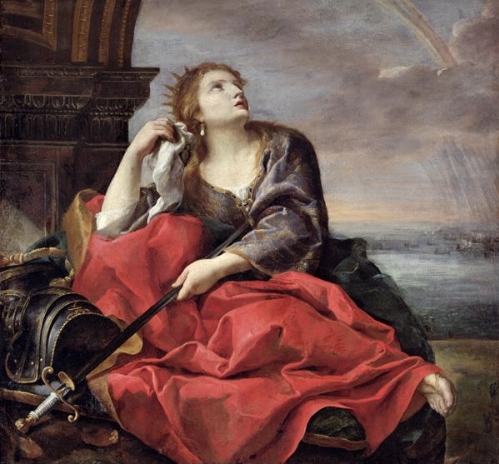Ancient Greek and Roman writers said that Dido was the founder and first Queen of Carthage. Carthage was a city in the country now known as Tunisia. Dido lived in the 9th century BC (about 3000 years ago). She is best known from the story about her in the Aeneid by the Roman poet Virgil. In some writings about her, she is called Alyssa or Elissa. She was also worshipped as a goddess in ancient Carthage.
She was married to Acerbas who was a priest of Hercules. When Dido’s brother Pygmalion killed Acerbas, Dido ran away. She took some of her people with her. They went first to Cyprus, and then to the north coast of Africa in the place now known as Tunisia.
Foundation of Carthage
Very early in ancient history, Phoenician sailors had visited the far corners of the Mediterranean sea and established commercial relations with the local people. Sidonian Phoenicians had established trading posts in the 16th century B.C. at Utica which is relatively close to where Carthage was later to be established. Their main objective was commercial to compete with their Tyrinian Phoenician brothers who had a colony at Utica. Archaeological evidence of the early settlements have been found. The position of Utica towards Carthage was precisely that of Sidon towards Tyre.
It was the more ancient city of the two, and it preserved a certain kind of position without actual power. Carthage and Utica competed, like Tyre and Sidon and they were at one time always spoken of together.Elissar and her Tyrinian entourage, including her priests and temple maidens of Ashtarte, crossed the length of the Mediterranean in several ships and settled the shores of what’s today modern Tunisia. Her expedition came and negotiated with the local inhabitants on purchasing a piece of land. Sailing into the Gulf of Tunis she spied a headland that would be the perfect spot for a city and chose the very site called Cambe or Caccabe which was an ancient Sidonian Phoenician trading post.
However, The king thought he was getting the better end of the deal, but he soon noticed that the woman he was dealing with was smarter than he had expected. This purchase contained some intrigue while the size of the land was thought not to exceed a “Bull’s Hide,” it actually was a lot larger then ever thought. The trick she and her expedition employed was that they cutup a bull’s hide into very thin which they sewed together into one long string. Then they took the seashore as one edge for the piece of land and laid the skin into a half-circle. Consequently, Elissar and her company got a much bigger piece of land than the king had thought possible. The Carthaginians continued to pay rent for the land until the 6th century BC. That hilltop today is called the “Byrsa.” Byrsa means “ox hide.” However, there is some confusion over the word; some believe that it refers to the Phoenician word borsa which means citadel or fortress. King Japon was very impressed by Elissar’s great mathematical talents and asked her to marry him. She refused, so he had a huge university built, hoping to find another young lady with similar talents instead.
On that “carved” site, Elissar and her colonial entourage founded a new city ca. 814 BC.3 They called it ‘Qart-Haddasht’ (Carthage) which comes from two Phoenician words that mean ‘New Land.” In memory of their Tyrinian origin, the people of Carthage paid an annual tribute to the temple of Melqart of Tyre in Phoenicia. The city of Carthage slowly gained its independence from Tyre though it was initially controlled by its own magistrates carrying the title of suffetes It kept close links with Tyre, the metropolis, until 332 BC.4 The colonization of Carthage, and thereafter, the territories around the western Mediterranean were a very successful endeavor that gave rise to the powerful Phoenician Punic dominions.
A western Mediterranean Phoenicians become known as Carthaginians. Later, Punic, a name used by the Romans to refer to western Mediterranean Phoenicians, was applied to all Carthaginians and the 300 city states and lands they came to occupy.
Chronology of Dido life according to F. M. Cross and Wm. H. Barnes:
- 839 BC: Dido was born in Tyre
- 825 BC: Dido flees Tyre in 7th year of Pygmalion, after the death of Acerbas
- 825 BC and possibly sometime thereafter: Dido and companions on Cyprus
- Between 825 BC and 814 BC: Tyrians build a settlement on the island of Cothon
- 814 BC: Dido founds Carthage on the mainland
- 785 BC: Death of Pygmalion
- 759 BC: Dido died in Carthage
What's happening in Tunisia?
Subscribe to our Youtube channel for updates.

















































